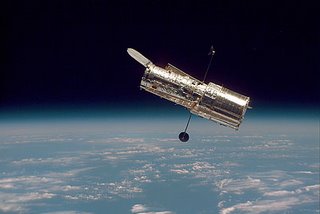
The Hubble Space Telescope’s primary camera is offline, with some science capabilities likely lost for good, NASA officials said Monday.
An electrical short in the backup system for Hubble’s Advanced Camera for Surveys (ACS) pushed the space telescope into a protective “safe mode” over the weekend and prompted the formation of an Anomaly Investigation Board on Monday, NASA officials said.
The incident, the third since June to hobble Hubble’s ACS camera, occurred at 7:34 a.m. EST (1234 GMT) on Jan. 27. Engineers managed to switch the space telescope back to normal operations, with the exception of the ACS instrument, by Sunday and hope to resume science observations with the observatory’s remaining instruments later this week.
NASA has convened an Anomaly Review Board to go over Hubble’s latest malfunction, the results of which are expected to be presented by March 2.
“Obviously, we are very disappointed by this latest event because of the popularity of the ACS instrument with astronomers,” NASA’s Preston Burch, Hubble program manager at the Goddard Space Flight Center (GSFC) in Greenbelt, Maryland, told reporters today in a teleconference.
It was Hubble’s ACS camera’s wide field channel, for example, that allowed astronomers to generate Hubble’s Ultra Deep Field – the deepest view into the universe to date. But that ACS channel, and a high-resolution channel used to study stars surrounded by planet-forming material, are likely lost since the latest glitch has cut off power to their systems, Hubble managers said.
“We’re not optimistic at all that those will be restored,” said David Leckrone, NASA’s senior project scientist for Hubble at the GSFC. “The saving grace here is that we have a superb new wide field camera coming along that was originally designed, in fact, to be a back up for ACS in case ACS failed. It was designed to work in tandem with ACS if [it] was full alive.”
That new camera – known as Wide Field Camera 3 – is due to be installed at Hubble during NASA’s last space shuttle flight to the observatory in September 2008.
Hubble engineers hope they will be able to restore partial ACS science capability with its third feature – the Solar Blind channel used recently to study auroras on Jupiter and Saturn – by February to aid NASA’s New Horizons mission, which is due to make a close flyby of Jupiter on Feb. 28.
“As soon as we’re confident that everyone has done their homework on that, we could very have the Solar Blind operating by the end of February,” Burch said. “That would be the hope.”
Hubble’s other, non-ACS instruments – the Field Planetary Camera 2, Near Infrared Camera Multi-Object Spectrograph, and the Fine Guidance Sensors – are unaffected by the recent glitch.
Hubble’s camera troubles
Hubble’s ACS camera has been working on its backup, or Side B, system since the instrument’s primary Side A electronics encountered a malfunction in June 2006. An electronics hiccup a few months later in September again knocked the camera offline, but the system recovered a short time later.
NASA Hubble managers said the most recent glitch is a completely isolated incident and is not connected to the earlier problems.
“It’s very different,” Burch said, adding that the current anomaly’s signature is very different from those seen last year.
Hubble managers have also prepared about six observation surveys that do not require the ACS camera just in case the finicky instrument went offline. Those research projects will now be implemented while the camera is unavailable.
The ACS anomaly comes just two months before the instrument’s projected five-year warranty expired, Hubble managers said. Spacewalking astronauts installed the camera on March 7, 2002 during NASA’s STS-109 mission aboard the Columbia orbiter. Launched in 1990, the Hubble Space Telescope has been billed as one of the most valuable astronomical instruments of all time and is the product of a partnership between NASA and the European Space Agency.
“It’s certainly been an astounding success as an instrument,” Rick Howard, acting director of NASA’s Astrophysics Division at NASA’s headquarters in Washington, D.C., adding that the camera met about all of its initial science objectives before its recent failure.
Because of the ACS camera’s hard-to-reach location on Hubble and the already packed five-spacewalk schedule of NASA’s final servicing mission to Hubble – Servicing Mission 4 slated to launch in September 2008 – adding a new and complicated repair job to the spaceflight is not an attractive option, Burch said.
“Servicing Mission 4 is a very full mission with installing new batteries and gyroscopes, installing one of the fine guidance sensors and two new instruments,” Burch said, adding that the initial plan carries no ACS-related additions to the upcoming Hubble overhaul.
Leckrone said that the new instruments to be grafted into Hubble during Servicing Mission 4 (SM-4) will almost completely restore the telescope’s lost ACS abilities, though the new Wide Field Camera 3 will take longer to generate its predecessor’s stunning views of the universe.
“The successful completion of SM-4 and insertion of Wide Field Camera 3 will take us fully back to not only where we are now, but where we want [Hubble] to be in the future,” Leckrone said.
No comments:
Post a Comment